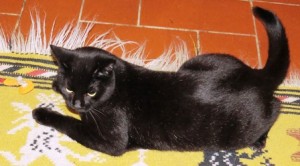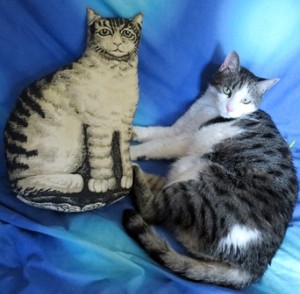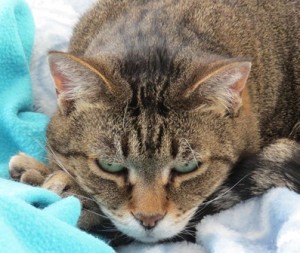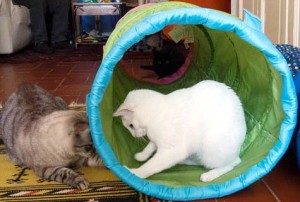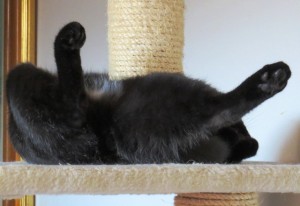Finally. Here goes. Are you ready? These are my first ramblings on the smoldering myeloma case report. 😉
At the end of the abstract, the authors state the following: These results suggest that patients with smoldering myeloma may benefit from daily ingestion of curcumin and long term use does not result in toxicity.”
Concerning possible long-term toxicity, let me say this: I’ve been on a higher daily dose than six grams for the past eight years (plus)…most of the time, an eight gram daily dose (note: I’ve been testing a lower dose lately, in the 7-gram range).
True, I don’t know what’s going on inside my cells, molecules, atoms and genes, but I can tell you this, for what it’s worth:
- I feel fine.
- I’m very active.
- I have no pain anywhere (the back pain I recently had, and wrote about on the blog, has totally disappeared…oh, and by the way, in case you remember that post and you’re still interested!, my urine is still clear! 😉 )…
- I haven’t taken an antibiotic in a year and a half. But I’ll have more to say about this in Part 2 of this post.
Before we go on, I would like to say that this study gave me a lot of food for thought, which means I have lots to say, so I’m bound to rant and rave and repeat (sorry about that!)… 😉
In the full study, we can read these two sentences: “Given the uncertainty of disease progression with SMM, early intervention aimed at reducing the abnormal protein load, the abnormal serum-free light chain ratio and the % plasma cell load would be of benefit to the patient. It would be essential that this preventative approach does not itself increase the risk of progression or result in toxicity.”
Long term readers of my blog know how I feel about early intervention. Or rather, I should add, about early conventional intervention. Simply put, I’m against it.
Very.
Strongly.
So.
Of course, this is MY OWN PERSONAL opinion, which is not based only on a gut feeling but on all the research I’ve done and all the scientific studies I’ve read in the past eight years (plus)…and also on the guidelines of the International Myeloma Working Group…
Anyway, that said, here’s what I believe: no CRAB symptoms = no intervention, no treatment.
I’ve lived a mainly healthy life thus far (more than eight years since my SMM diagnosis and fourteen years since my MGUS diagnosis). Yet the percentage of evil plasma cells in my bone marrow is (probably still) quite high, to the point where, in 2007, my hematologist, based on what she knew (protocols protocols protocols), suggested that I take some Revlimid to bring down that number. I said no, to her surprise…but it was my decision, right or wrong (for the record: I think I made the right choice).
But getting back to what Terry Golombick and his colleagues write…No, we certainly do NOT want to increase our risk of progression and/or make our lives miserable because of the toxic side effects of conventional treatments. I’m referring, of course, to MGUS and SMM situations, with no CRABs…
But that doesn’t mean that we should sit back and do nothing. I can still hear the words that a world-famous myeloma specialist told me over the phone in 2005: “No, there is nothing you can do to stop it from progressing.”
Nothing is unacceptable. Simply unacceptable.
And all those expressions that give absolutely no hope to the patient should be DELETED from the myeloma vocabulary. Words such as “watch and wait.” The only thing I “watch and wait” for are birds when Stefano and I go bird watching…
Sure, perhaps there isn’t anything I can do. Perhaps I’ll progress to active myeloma at some point, no matter what I do—even if I stand on my head every night at midnight singing an aria from “La Traviata”…even if I walk around with a pineapple precariously balanced on my head…even if I sleep all day like my cats do…even if…
But (seriously now!) here’s the thing: while it goes without saying that I want my hematologist to give me the truth, the straight and honest truth, I also don’t want her to give me what Dr. David Servan-Schreiber, the famous French neuroscientist and physician, called false hopelessness. Here’s an interesting 2008 article on this topic: http://goo.gl/oeJh5
Dr. Servan-Schreiber believed that feelings of helplessness can actually feed cancer. I’m convinced that’s true. But I’ve written about all this before and don’t want to repeat it, so just go have a look at my March 13 2011 post if you have no idea what I’m blabbing about: http://margaret.healthblogs.org/2011/03/13/hope/.
In spite of all the evidence that patients who are given hope do better than those who are given no hope, the current conventional approach in the MGUS and SMM world is to tell us that there is nothing we can do. Does that make any sense to you? And some doctors, like Vermorken and his team, go as far as to suggest that it might actually be DANGEROUS for us to do something like use turmeric in our cooking. I mean…you’ve got to be bloody KIDDING!!!! But that’s fodder for another post that I’m working on (grrrrrrimace!), so I’ll leave it at that for now.
Point is: watching and waiting and doing bloody nothing is no way to live. It takes power away from us. It makes us feel weak and afraid and anxious…It gives us a sense of despair and helplessness. All these negative feelings can only lead to the buildup of stress. And stress, as we should all know by now, feeds myeloma cells (look up “norepinephrine” on my blog or scroll down my Pages to the title “Myeloma and stress,” which, yes, needs some updating!).
Here’s what I firmly believe (and again, it’s MY OWN OPINION blablabla): we CAN be proactive in a way that doesn’t risk waking up the monster inside of us. We have to be incredibly careful, of course, not to take anything toxic and without solid scientific backing…and not to go overboard. For example, I’m not a fan of drastic changes…”cold turkey” dietary changes, e.g. Do things gradually. Easy peasy.
And for cryin’ out loud, if you really want that slice of chocolate cake or apple tart, go ahead and have it! 😉
As for being proactive, sure, I’ve had my doubts, too. Have I made the right choices or have I totally screwed up? Well, it’s pointless to dwell on all that. I don’t have a time machine, so I can’t go back to 2005-6 and do things differently. And, to be honest, even if I were offered that opportunity, I would ignore it. I doubt that I could have done any better…But, of course, only time (more time!) will tell. 🙂
A final rambling: even if you don’t believe in taking supplements or making any dietary changes, you can do other things. Laugh. Enjoy your life…even the little things…learn something new…travel…relax (meditate)…be with your loved ones and friends as much as possible…cuddle with your cats…do whatever makes you happy…and hey, don’t forget to eat some chocolate. 😉
I’ll stop here for today. Note: the second part of my post is not as rambling as this one but instead focuses on a part of the study that should be of interest to all of us… Ciao for now! 🙂
